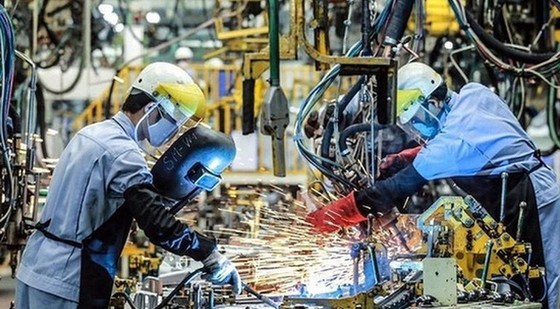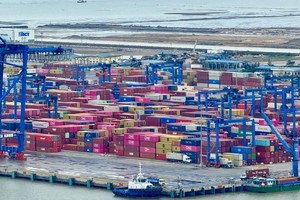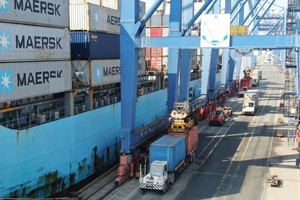As the growth in Gross Domestic Product (GDP) in the first six months of the year was not as high as expected, we need to mobilize all our domestic resources in the last six months of the year to gain momentum in growth and development to make up for the losses incurred so far this year.
 |
This is the viewpoint of Dr. Nguyen Thi Huong, General Director of the General Statistics Office, as expressed in her talk with Saigon Investment.
JOURNALIST: - Ma’am, how do you see the economic picture that has been presented in the first six months of the year?
Dr. Nguyen Thi Huong: - As an open economy, we have been greatly affected by the complicated and unpredictable fluctuations in the global economy which has been seeing a significant decline over the past months. Nonetheless, the macro economy remains stable, inflation has been controlled to an adjustable level, production, and business activities since May and June are gradually picking up, and many key enterprises have stabilized their production base.
The GDP in the second quarter reached 4.14 percent, which is 0.86 percent higher than the increase of 3.28 percent in the first quarter. In the first six months of the year, economic growth reached 3.72 percent, although it was not as expected. However, this is encouraging growth and is the result of the effort to promote domestic resources. This internal force is evident in all three economic sectors of agriculture, forestry, and fisheries, with positive and stable growth with an increase of 3.25 percent over the same period last year. This area is still the foundation of the economy that ensures food supply and security, and agricultural produce as a source for exports.
The construction industry sector temporarily ended its negative growth momentum from the first quarter and achieved a growth rate of 1.56 percent, a decrease of 0.75 percent in the first quarter. The construction industry also experienced high growth with an increase of 7.05 percent, higher than the increase of 4.94 percent in the same period last year, due to drastic measures taken to accelerate public investment. There was an increase of about 22 percent in public investment, in which investment in the state sector increased by 12.6 percent.
- Ma’am, is the decline in import and export and slow disbursement of capital for public investment projects the reasons for slow economic growth in the first six months of the year?
- The decline in import and export turnover is not only limited to Vietnam, because out of 16 major economies in the world, 13 countries saw a decline in exports, and 12 countries faced a decline in imports in April. Therefore, in general, Vietnam's import-export turnover in the first six months of the year is considered a bright spot in the context of a decline in world aggregate demand. At the same time, Vietnam's trade balance of goods reached US$12.3 bln, the highest in the last ten years, which also contributed greatly to its economic growth.
Regarding public investment, the first six months of the year only achieved 33 percent of the capital plan assigned to the whole year of 2023, and there is still a very large amount up to 67 percent that needs to be implemented to achieve the goals as per Directive 08. It has been proposed that under Directive 08 up to 100 percent of the capital plan will be disbursed in 2023. Although the amount of capital implemented in six months reached only about one-third of the whole year plan, with the disbursement of more than VND 232,200 billion, it is a very large number. This clearly shows the drastic direction taken by the Government and the determination of ministries, branches, and localities in accelerating the implementation of projects and key works right from the first months of the year.
- Ma’am, what problems are created in the economy from a decline in businesses?
- In the first six months of the year, 113,550 newly established enterprises returned to the market, down by 2.9 percent over the same period last year. But there were also 100,000 enterprises withdrawing from the market, an increase of 19.7 percent. Through the data received on business registration, it can be seen that enterprises are facing difficulties in business capital, which is reflected in the total registered capital of newly established enterprises only reaching VND 707,457 billion, equal to about 80 percent in the same period in the years affected by the Covid-19 pandemic. The average registered capital per enterprise in the first six months of the year was only VND 9.3 billion, the lowest in the first six months since 2017. The additional registered capital of operating enterprises also decreased by 48.1 percent compared to the same period in 2022.
Business capital is difficult, but even if interest rates have been reduced relatively, the ability of enterprises to absorb capital is still limited. In just three months, the State Bank of Vietnam has adjusted the interest rate down four times with a reduction of 0.5 percent to 2 percent per year. But credit growth is still low, as of 20 June it only increased by 3.13 percent compared to 2022, less than a quarter of the year's credit growth target of about 15 percent. The slow growth of credit shows the difficult situation of enterprises such as lack of orders, difficult output, large inventory, reduced demand for new loans for production, and many enterprises having no viable business plans for the future.
- Ma’am, there is an opinion that the economy has not bottomed out yet. How do you forecast the situation?
- With the drastic management of the Government, the efforts of all economic sectors and the consensus of the people, industrial production in the last six months of 2023 will certainly prosper. The future will also see many favorable factors. First, imports and exports will see positive signs after receiving the economic data from a number of developed economies such as the US and Japan, and also with the reopening of China. This will create opportunities for exports from Vietnam.
Second, domestic consumption is continuing to recover, and tourism is expected to prosper in months to come. Inflation is slowing down and is well under control, and the decrease in bank interest rates is a positive sign toward stimulating consumer demand. Once there is an increase in domestic demand there will be a more robust market economy in the future.
























